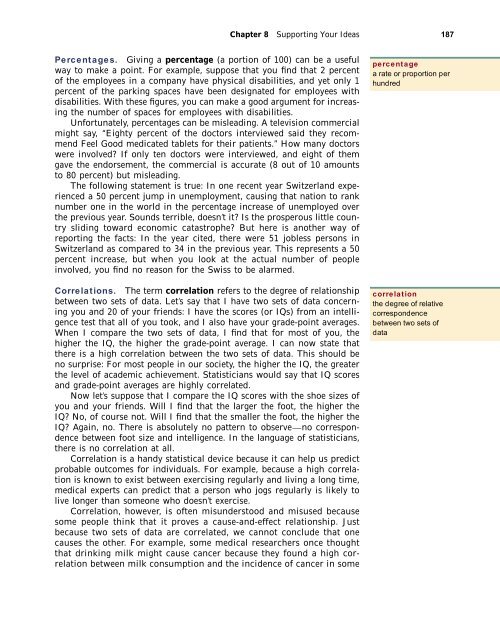Nurul Izzah Anwar, an engineering major at a college in Malaysia ...
Nurul Izzah Anwar, an engineering major at a college in Malaysia ...
Nurul Izzah Anwar, an engineering major at a college in Malaysia ...
Create successful ePaper yourself
Turn your PDF publications into a flip-book with our unique Google optimized e-Paper software.
Chapter 8 Support<strong>in</strong>g Your Ideas 187<br />
Percentages. Giv<strong>in</strong>g a percentage (a portion of 100) c<strong>an</strong> be a useful<br />
way to make a po<strong>in</strong>t. For example, suppose th<strong>at</strong> you f<strong>in</strong>d th<strong>at</strong> 2 percent<br />
of the employees <strong>in</strong> a comp<strong>an</strong>y have physical disabilities, <strong>an</strong>d yet only 1<br />
percent of the park<strong>in</strong>g spaces have been design<strong>at</strong>ed for employees with<br />
disabilities. With these figures, you c<strong>an</strong> make a good argument for <strong>in</strong>creas<strong>in</strong>g<br />
the number of spaces for employees with disabilities.<br />
Unfortun<strong>at</strong>ely, percentages c<strong>an</strong> be mislead<strong>in</strong>g. A television commercial<br />
might say, “Eighty percent of the doctors <strong>in</strong>terviewed said they recommend<br />
Feel Good medic<strong>at</strong>ed tablets for their p<strong>at</strong>ients.” How m<strong>an</strong>y doctors<br />
were <strong>in</strong>volved? If only ten doctors were <strong>in</strong>terviewed, <strong>an</strong>d eight of them<br />
gave the endorsement, the commercial is accur<strong>at</strong>e (8 out of 10 amounts<br />
to 80 percent) but mislead<strong>in</strong>g.<br />
The follow<strong>in</strong>g st<strong>at</strong>ement is true: In one recent year Switzerl<strong>an</strong>d experienced<br />
a 50 percent jump <strong>in</strong> unemployment, caus<strong>in</strong>g th<strong>at</strong> n<strong>at</strong>ion to r<strong>an</strong>k<br />
number one <strong>in</strong> the world <strong>in</strong> the percentage <strong>in</strong>crease of unemployed over<br />
the previous year. Sounds terrible, doesn’t it? Is the prosperous little country<br />
slid<strong>in</strong>g toward economic c<strong>at</strong>astrophe? But here is <strong>an</strong>other way of<br />
report<strong>in</strong>g the facts: In the year cited, there were 51 jobless persons <strong>in</strong><br />
Switzerl<strong>an</strong>d as compared to 34 <strong>in</strong> the previous year. This represents a 50<br />
percent <strong>in</strong>crease, but when you look <strong>at</strong> the actual number of people<br />
<strong>in</strong>volved, you f<strong>in</strong>d no reason for the Swiss to be alarmed.<br />
Correl<strong>at</strong>ions. The term correl<strong>at</strong>ion refers to the degree of rel<strong>at</strong>ionship<br />
between two sets of d<strong>at</strong>a. Let’s say th<strong>at</strong> I have two sets of d<strong>at</strong>a concern<strong>in</strong>g<br />
you <strong>an</strong>d 20 of your friends: I have the scores (or IQs) from <strong>an</strong> <strong>in</strong>telligence<br />
test th<strong>at</strong> all of you took, <strong>an</strong>d I also have your grade-po<strong>in</strong>t averages.<br />
When I compare the two sets of d<strong>at</strong>a, I f<strong>in</strong>d th<strong>at</strong> for most of you, the<br />
higher the IQ, the higher the grade-po<strong>in</strong>t average. I c<strong>an</strong> now st<strong>at</strong>e th<strong>at</strong><br />
there is a high correl<strong>at</strong>ion between the two sets of d<strong>at</strong>a. This should be<br />
no surprise: For most people <strong>in</strong> our society, the higher the IQ, the gre<strong>at</strong>er<br />
the level of academic achievement. St<strong>at</strong>istici<strong>an</strong>s would say th<strong>at</strong> IQ scores<br />
<strong>an</strong>d grade-po<strong>in</strong>t averages are highly correl<strong>at</strong>ed.<br />
Now let’s suppose th<strong>at</strong> I compare the IQ scores with the shoe sizes of<br />
you <strong>an</strong>d your friends. Will I f<strong>in</strong>d th<strong>at</strong> the larger the foot, the higher the<br />
IQ? No, of course not. Will I f<strong>in</strong>d th<strong>at</strong> the smaller the foot, the higher the<br />
IQ? Aga<strong>in</strong>, no. There is absolutely no p<strong>at</strong>tern to observe—no correspondence<br />
between foot size <strong>an</strong>d <strong>in</strong>telligence. In the l<strong>an</strong>guage of st<strong>at</strong>istici<strong>an</strong>s,<br />
there is no correl<strong>at</strong>ion <strong>at</strong> all.<br />
Correl<strong>at</strong>ion is a h<strong>an</strong>dy st<strong>at</strong>istical device because it c<strong>an</strong> help us predict<br />
probable outcomes for <strong>in</strong>dividuals. For example, because a high correl<strong>at</strong>ion<br />
is known to exist between exercis<strong>in</strong>g regularly <strong>an</strong>d liv<strong>in</strong>g a long time,<br />
medical experts c<strong>an</strong> predict th<strong>at</strong> a person who jogs regularly is likely to<br />
live longer th<strong>an</strong> someone who doesn’t exercise.<br />
Correl<strong>at</strong>ion, however, is often misunderstood <strong>an</strong>d misused because<br />
some people th<strong>in</strong>k th<strong>at</strong> it proves a cause-<strong>an</strong>d-effect rel<strong>at</strong>ionship. Just<br />
because two sets of d<strong>at</strong>a are correl<strong>at</strong>ed, we c<strong>an</strong>not conclude th<strong>at</strong> one<br />
causes the other. For example, some medical researchers once thought<br />
th<strong>at</strong> dr<strong>in</strong>k<strong>in</strong>g milk might cause c<strong>an</strong>cer because they found a high correl<strong>at</strong>ion<br />
between milk consumption <strong>an</strong>d the <strong>in</strong>cidence of c<strong>an</strong>cer <strong>in</strong> some<br />
percentage<br />
a r<strong>at</strong>e or proportion per<br />
hundred<br />
correl<strong>at</strong>ion<br />
the degree of rel<strong>at</strong>ive<br />
correspondence<br />
between two sets of<br />
d<strong>at</strong>a

















